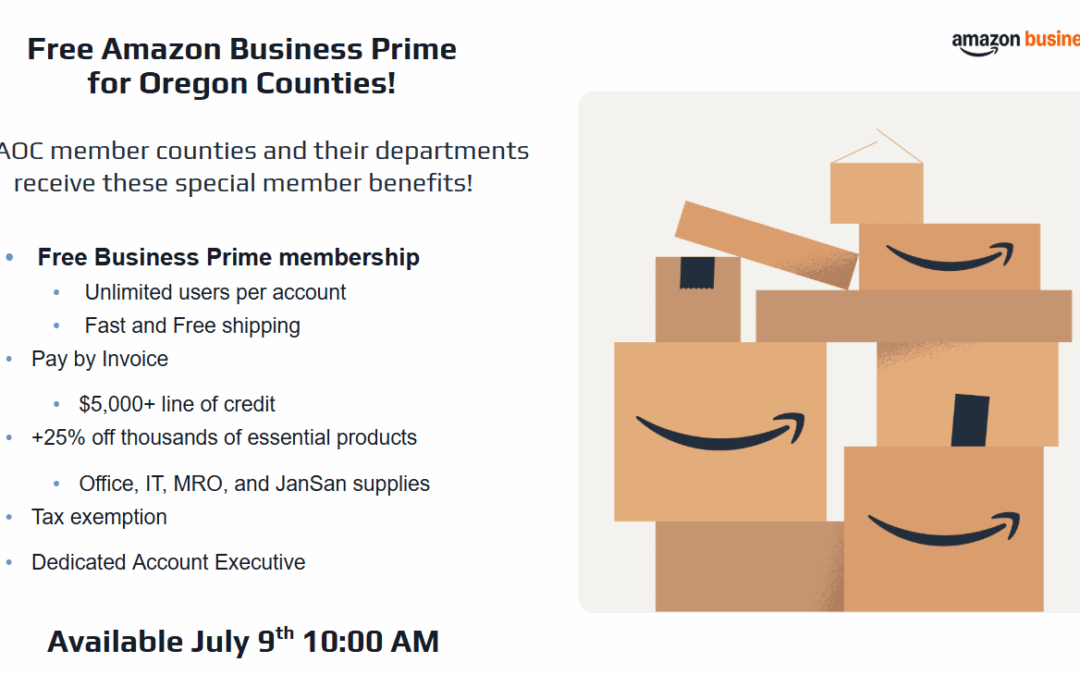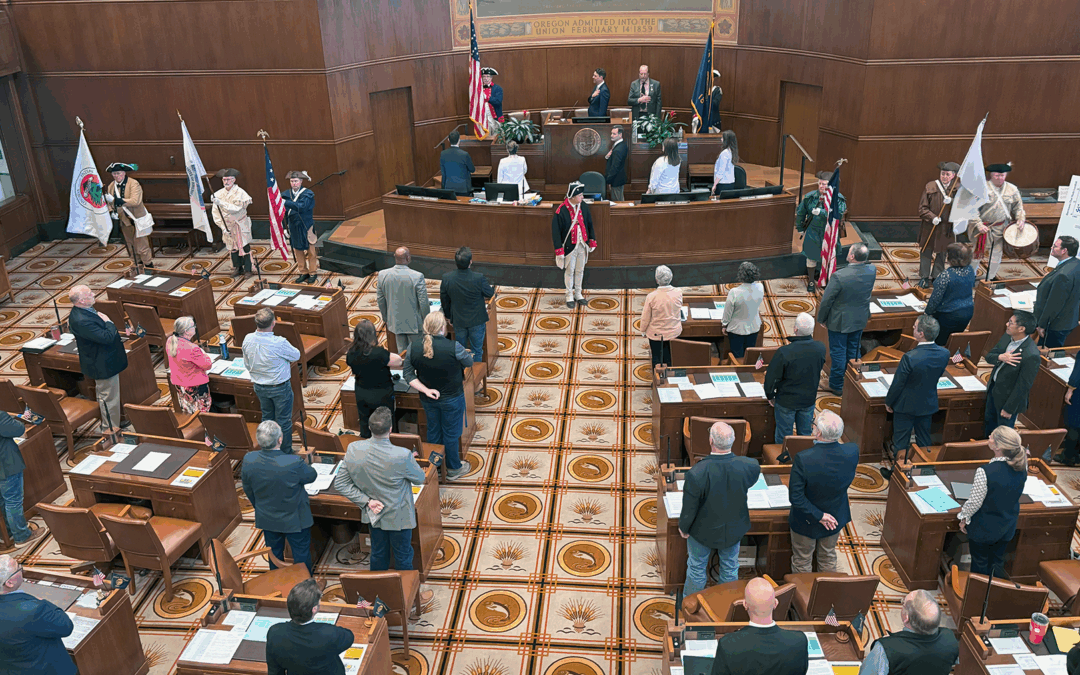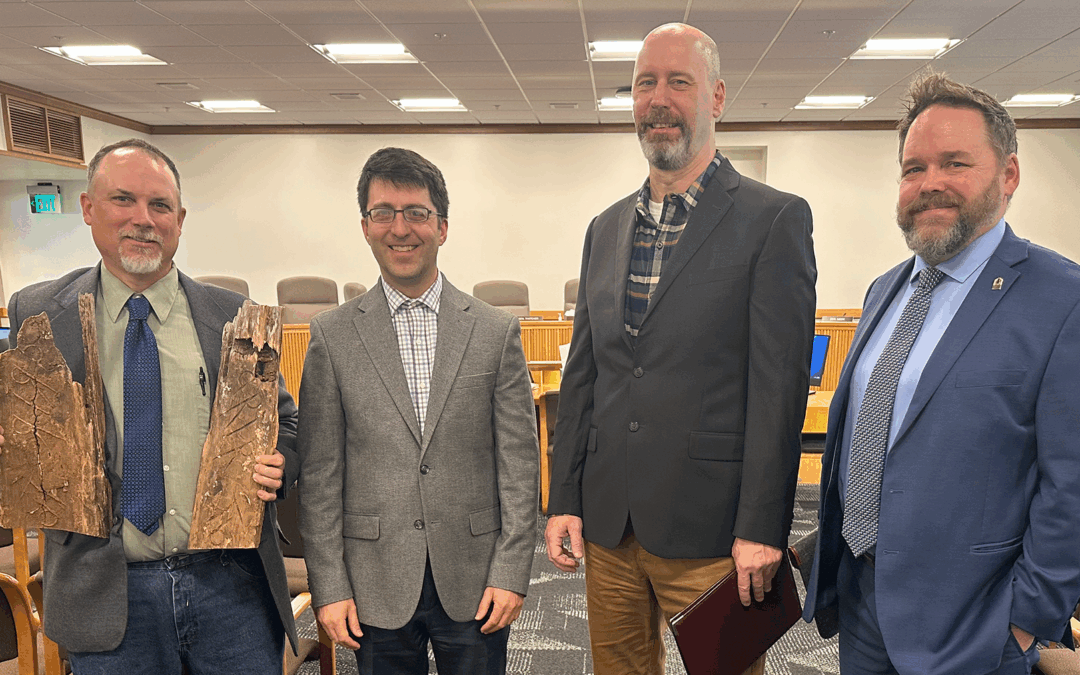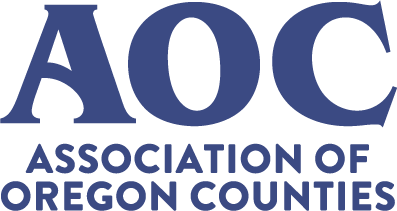
May 29, 2025 | AOC Business Partner
Purchasing can be challenging and a strain on county budgets. Thanks to a new partner opportunity, Association of Oregon Counties (AOC) members and their county departments can take advantage of free Amazon Business Prime for the entire county which is approximately a $3,499 value.
In addition to receiving free Business Prime, members can access exclusive benefits including a pre-approved $5,000+ line of credit with a pay-by-invoice option. Other benefits include discounts on thousands of products across various counties. By signing up, member counties and their departments can maximize savings in their procurement process.
Member counties who are already paying for Business Prime can receive a prorated refund after signing up. These benefits can be activated on current accounts with no need to create new accounts.
AOC and Amazon Business are offering a webinar on July 9, at 10 a.m., to explain the opportunity and to activate the benefits for participants. Staff responsible for making purchases on behalf of the county are encouraged to register and attend the webinar. Amazon Business account executives will be available during the webinar and afterwards to answer questions and help participants get signed up and activated.
By attending the webinar, members will receive the exclusive AOC Benefit Link and code needed to activate their free Business Prime. The webinar will be presented by Lizette Flore, Amazon Business Senior Account Executive and Tessa Sullivan, Amazon Business Program Manager.
Questions about the webinar or about the business partnership program can be directed to partnerprogram@oregoncounties.org.

May 23, 2025 | AOC News
The Association of Oregon Counties (AOC) is pleased to announce the hiring of Julie Oke as its new office administrator.
Julie brings extensive experience in local government and association support. Her background includes a broad range of expertise in office operations, event coordination, digital communications, and member services. Julie’s deep understanding of the needs of local governments and commitment to public service will be a valuable asset to AOC and its members.
“We are thrilled to welcome Julie to the AOC team,” said Executive Director Gina Nikkel. “Her proven experience and dedication to supporting Oregon’s communities make her an excellent fit for this role.”
Julie’s first day was Monday, May 19.
Contributed by: Erin Good | Communications Coordinator

May 1, 2025 | AOC Advocacy, AOC News
The Association of Oregon Counties (AOC) Legislative Affairs Department had a productive month advocating for AOC’s priority bills. Most of the bills supported by AOC advanced through the first chamber deadline in April, while several bills opposed by AOC have been amended to mitigate our concerns or will not move forward this session.
Adding to a strong month of engagement, AOC members joined legislators on the Senate floor on April 14 to receive courtesies of the Senate. Senator David Brock Smith, a former Curry County commissioner, highlighted the wide range of public services that Oregon counties deliver to all Oregonians. This event took place amid a particularly intense legislative session. A record 3,400+ bills were introduced this session. After an oftentimes chaotic and reactive 12-week sprint, and only about half of those bills survived the first chamber deadline and the potential to move forward this session.
About 500 budget bills and policy bills with a funding component await action in the Joint Committee on Ways and Means. Following the May 14 revenue forecast, legislative budget writers will start to narrow that universe significantly, making difficult decisions about how to allocate the state’s general fund. The second chamber work session is just around the corner — policy bills must be posted for a work session in the second chamber policy committee by May 9, or they will not be able to move forward this session.
Below are updates on AOC’s 2025 session top policy and budget priorities. A comprehensive bill list is available on AOC’s Legislative Committee webpage and is regularly updated throughout the session.
Assessment and Taxation Funding
Conversations and negotiations around House Bill 3518, AOC’s Assessment and Taxation Funding proposal with members of the House Committee on Revenue and stakeholders are ongoing – an amendment is expected soon. The Senate Committee on Finance and Revenue held an informational meeting on county assessment and taxation last week and the presentation garnered productive conversation with the committee. AOC remains optimistic that a solution for this long-time priority issue will move forward this session.
Community Corrections Funding
The April corrections population forecast showed a substantial decline in the projected population for individuals on community supervision. This is both good and bad news. The baseline budget is substantially smaller, and the cost study is more affordable. However, because funding is allocated per person, it becomes even more critical to fully fund the study. AOC continues to be engaged with the co-chairs of the Ways and Means Public Safety subcommittee and have received positive feedback about fully funding the cost study.
Health and Human Services
AOC is advocating for funding to meet counties’ statutory obligations for behavioral health, public health, and intellectual and developmental disabilities services; adequate statewide funding for effective deflection programs; and maintenance of homelessness response infrastructure and local coordination.
The following AOC priority bills have been referred to the Joint Committee on Ways and Means with “do pass” recommendations:
- House Bill 2056 allocates $64.8 million to Community Mental Health Programs to ensure they can deliver the critical crisis intervention, civil commitment, and aid and assist services required by law.
- House Bill 2015, requiring OHA to study and report on ways to make residential treatment facilities operations more sustainable;
- House Bill 2059, allocates $90 million to continue to build residential addiction treatment capacity; and
- House Bill 3916, allocating $5 million for local health workforce development – also moved out of policy committees to the Joint Committee on Ways and Means with do pass recommendations.
AOC’s county deflection program cost survey yielded a statewide projection of $47 million base funding needed for both counties and tribes, which is $7 million more than the governor’s recommended budget. Bills to further refine Ballot Measure 110-related programs, including improved transparency and coordination of Behavioral Health Resource Network grantmaking with the local behavioral health system, are being negotiated by legislative leadership. The suite of civil commitment reform bills under consideration were moved to the Joint Committee on Addiction and Community Safety Response for ongoing negotiation apart from the chamber deadlines.
State Forest Harvest Revenue
The Council of Forest Trust Land Counties testified in strong support of House Bill 3103 at its public hearing earlier this month. This bill would require a sustainable harvest in the state forests, providing a level of certainty to the trust land counties that rely on these harvest revenues. HB 3103 was moved to the Joint Committee on Ways and Means with unanimous support.
Transportation Funding Package
The co-chairs of the Joint Committee on Transportation released the much-anticipated transportation package framework last week, now known as the Oregon Transportation ReInvestment Package (TRIP). The initial framework includes increases to existing funding mechanisms and several new mechanisms. Total projected funding from the proposal equates to a 70% increase to counties over current projected revenues. AOC staff will continue to advocate for the principles and priorities set by our Legislative Committee in negotiations on a final package.
Water
All of AOC’s priority water bills, including place-based water planning, were referred to the Joint Committee on Ways and Means for further consideration.
Wildfire
A series of bills have been introduced based on Wildfire Funding Workgroup recommendations: HB 3940, HB 3947, SJR 11, SB 1177, and SB 1132. All of the bills moved to committees not subject to the first chamber deadline without recommendation for further discussion and negotiation.
Wolf Depredation Grants
Senate Bill 777 A makes updates to the Wolf Depredation and Compensation Grant Program housed at the Oregon Department of Agriculture – a longtime priority of AOC. Counties took the lead on the wolf depredation legislative concept, which will help bring additional deterrence to the landscape and more ranchers into the program. After over a decade of failed attempts at updates to the program, SB 777 passed out of the Senate 28-1 and had a positive public hearing yesterday in the House Committee on Agriculture, Land Use, Natural Resources, and Water.

Apr 30, 2025 | AOC Advocacy, AOC News, Transportation
The Co-Chairs of the Joint Committee on Transportation recently released a framework for the 2025 Transportation ReInvestment Package (TRIP). New revenue proposed in the framework equates to a 70% increase in statewide county road department funding over current projections. According to the 2024 County Road Needs Study, counties statewide face a $834 million/year funding shortfall – the TRIP framework makes significant progress toward filling that gap.
The TRIP framework aligns with the Association of Oregon Counties (AOC) Legislative Committee’s transportation priority by maintaining the 30% county share and modernizing State Highway Fund (SHF) revenue mechanisms. The framework also directs 90% of all new revenue to safety, maintenance, and preservation across the shared transportation system.
“Advocacy from counties will be critical to maintaining these proposed investments and the county 30% share of the SHF in the final package,” urged Legislative Affairs Director Mallorie Roberts.
While bill language is expected to be released by early May, with public hearings in the Joint Committee on Transportation to follow, negotiations among legislators are already underway. AOC has prepared talking points (linked below) based on AOC’s transportation package priority and principles which can be used as a starting point to engage with the Legislature and the media.
AOC appreciates your advocacy and engagement in this top priority issue for AOC and counties. Please copy AOC Legislative Affairs Director Mallorie Roberts on emails to legislators, and if you have any questions please don’t hesitate to reach out.
Resources

Apr 30, 2025 | AOC News
Polk County Survey Crew Chief Josh Herzberg, Lincoln County Surveyor Eli Adam, Clatsop County Surveyor Vance Swenson, and Lane County Deputy County Surveyor Trevor Ross (L-R)
House Bill 3175 passed unanimously out of the Senate Committee on Veterans, Emergency Management, and Federal and World Affairs this week. The bill lifts the statutory 40-year-old cap on the document recording fees that go to county surveyors’ Public Land Corner Preservation Funds, and now moves to the Senate floor for a vote, then to the governor’s desk to be signed into law.
Removing the $10 fee cap, which was set in statute in the 1980s, allows boards of county commissioners and county courts to set a document recording fee commensurate to local needs. If passed out of the Senate and signed by the governor, HB 3175 would go into effect on Jan. 1, 2026.
County Public Land Corner Programs are struggling to meet their statutory obligations to maintain public land corners due to the decline of the $10 fee’s value – down 70% since it was set in the 1980s. Modernizing this funding mechanism has been a legislative priority for the Association of Oregon Counties (AOC) and the Oregon Association of County Engineers and Surveyors (OACES) for nearly 20 years, though past attempts to pass legislation have failed.
Oregon county surveyors have been maintaining and perpetuating the Public Land Survey System (PLSS) – critical public infrastructure established by the federal government in 1785 – since statehood. The PLSS consists of controlling property corners located every half mile, forming the foundation for all public and private real property and resource land boundaries in Oregon. Maintaining these corners is an ongoing process requiring physical inspection and establishment or reestablishment of historical corners still set in trees or with rocks. Over time, corners are destroyed and damaged by natural events, development, and careless human activity. When corners are destroyed or improperly placed, every landowner’s property lines become less certain, resulting in costly boundary disputes and litigation, disorderly development, and emergency response challenges.
HB 3175 was introduced by Representative Marsh (D-Ashland) and Representative Gomberg (D-Otis) on behalf of the Association of Oregon Counties (AOC) and the Oregon Association of County Engineers and Surveyors (OACES). OACES members Polk County Survey Crew Chief Josh Herzberg, Lincoln County Surveyor Eli Adam, Clatsop County Surveyor Vance Swenson, Lane County Deputy County Surveyor Trevor Ross, and Wasco County Surveyor Bradley Cross testified in the House and Senate Committees.
Contributed by: by Mallorie Roberts | AOC Legislative Affairs Director





